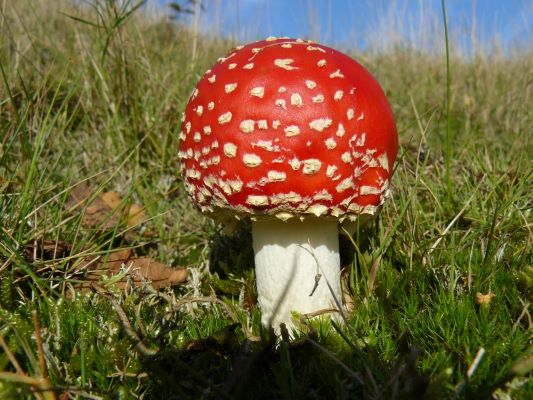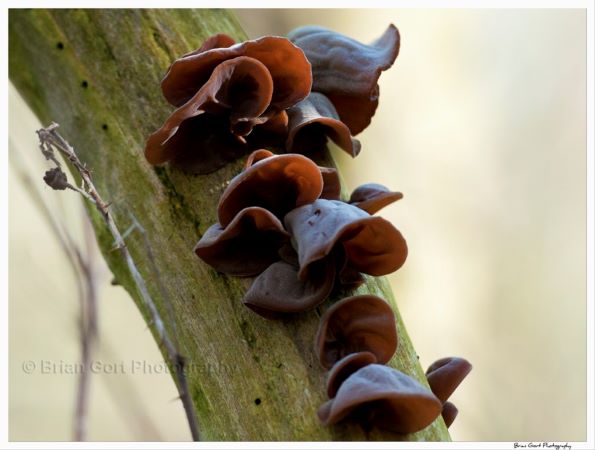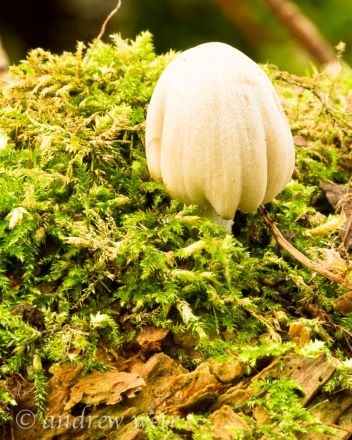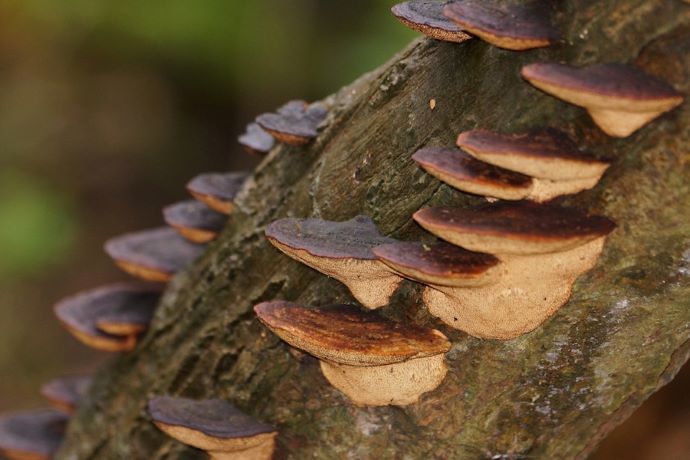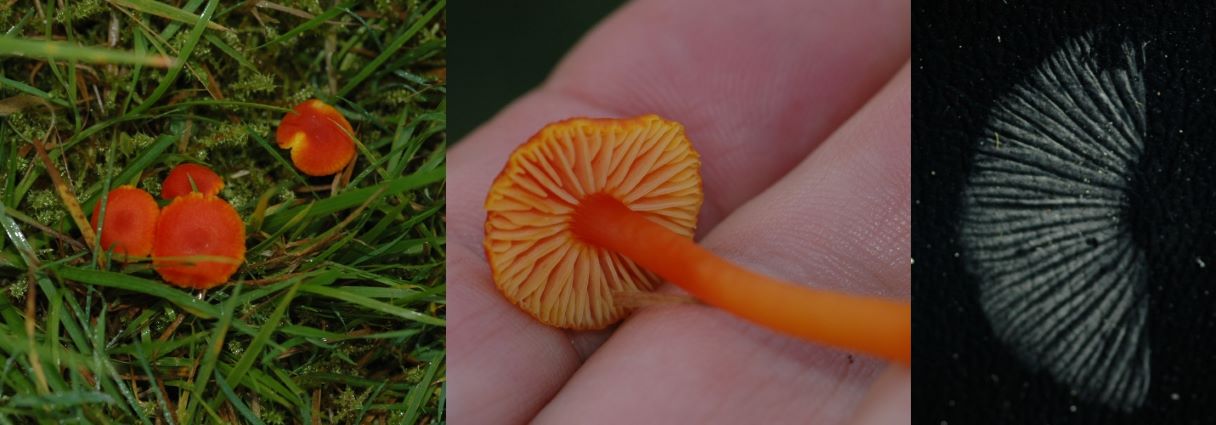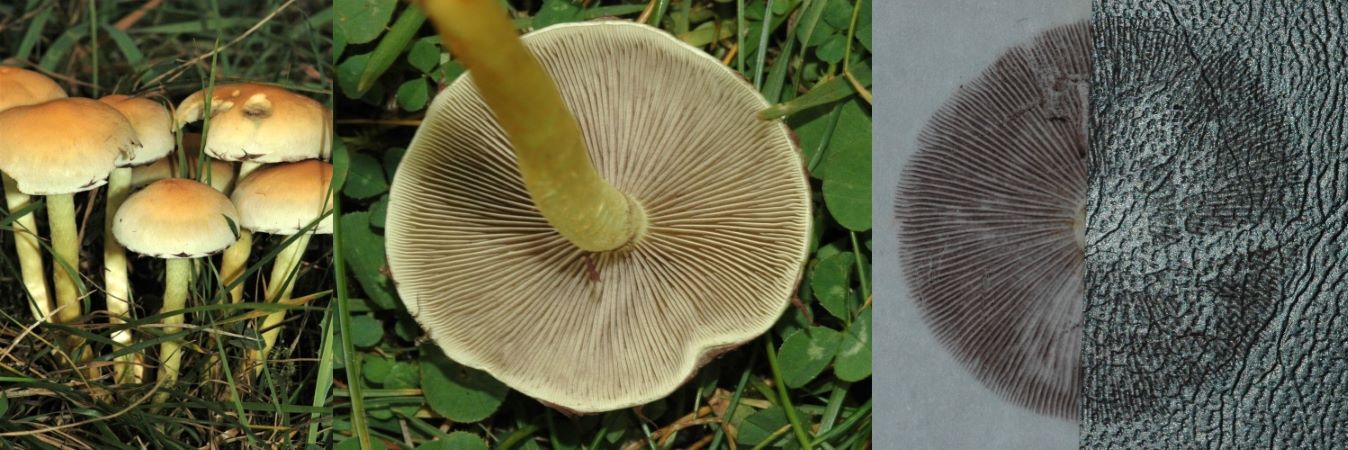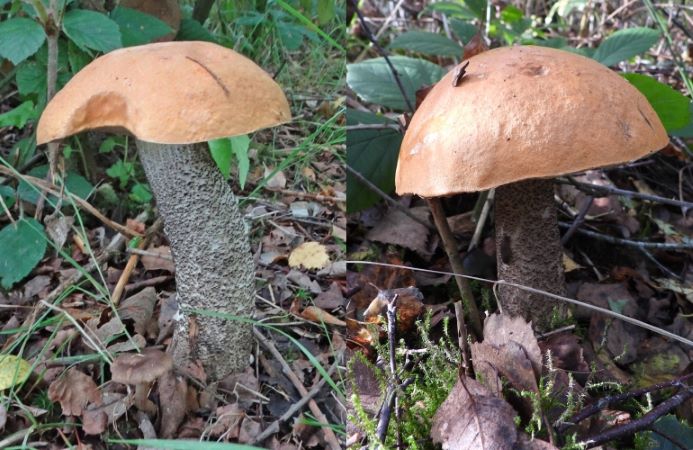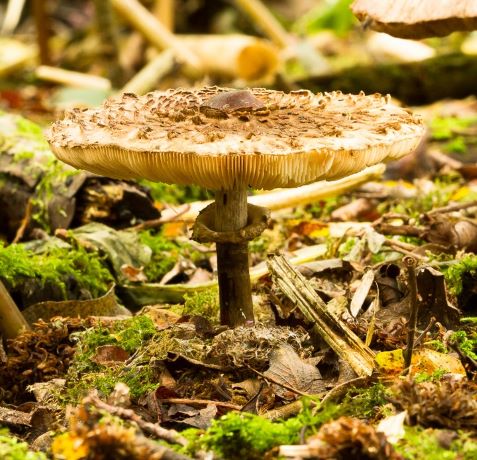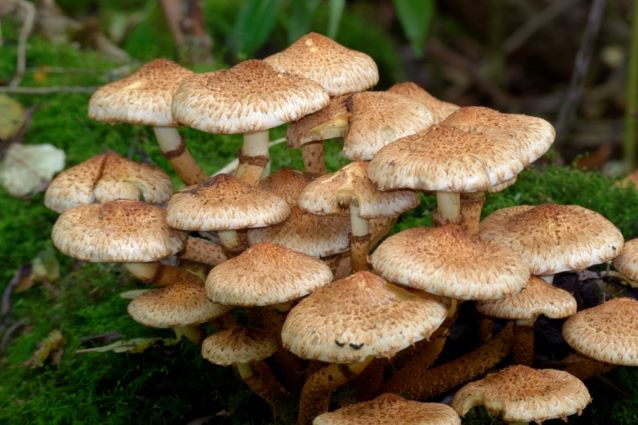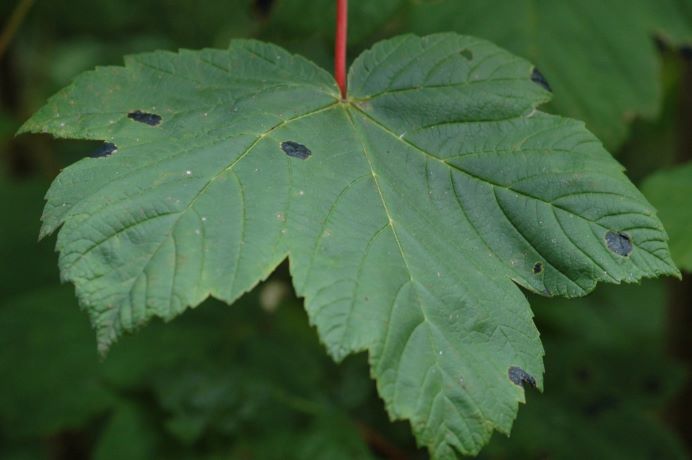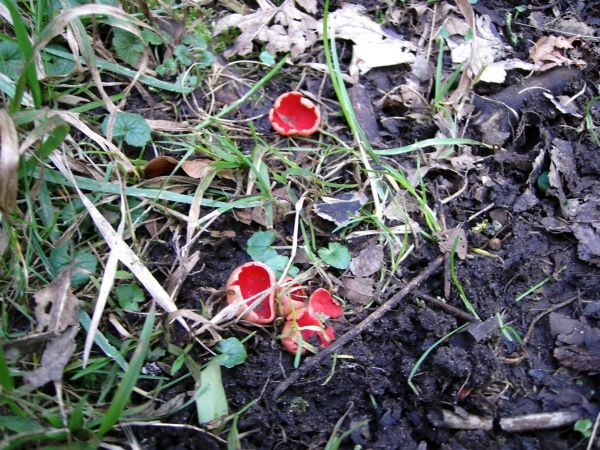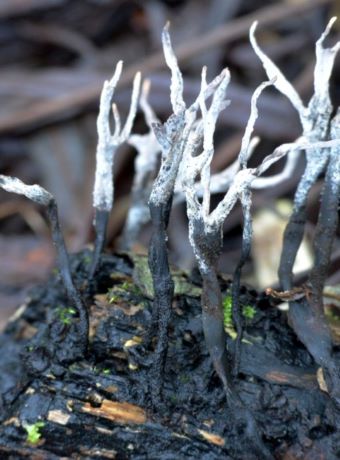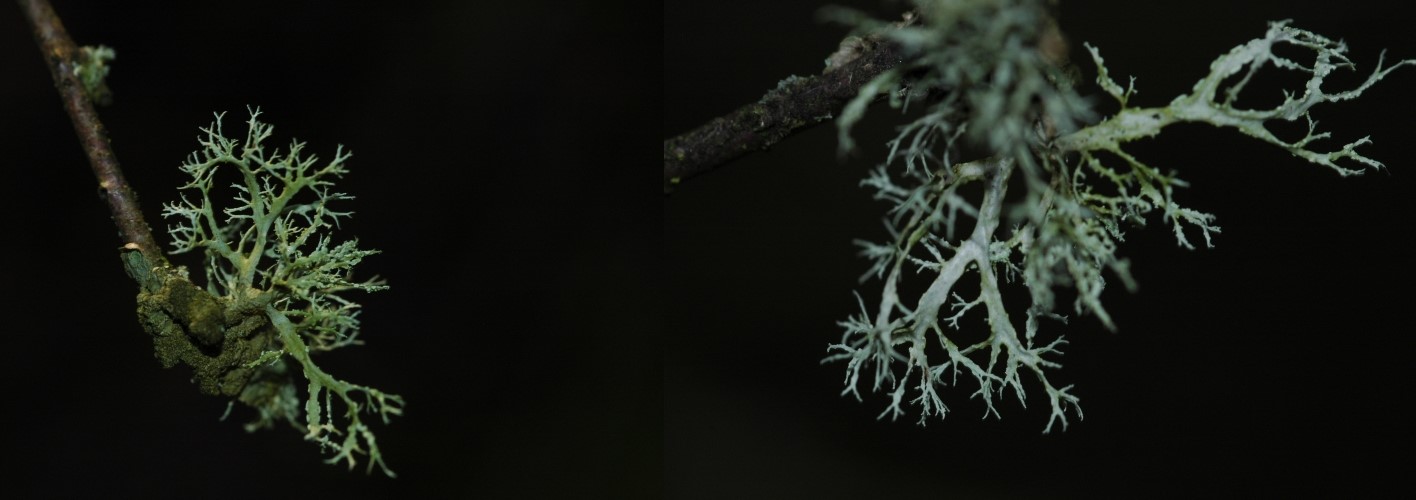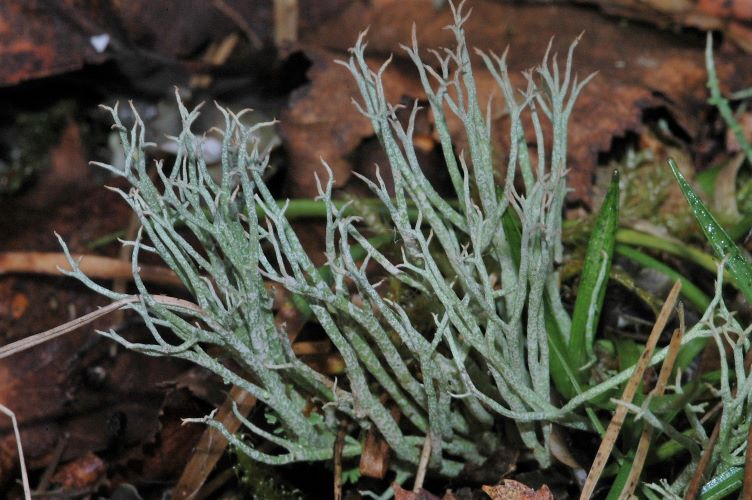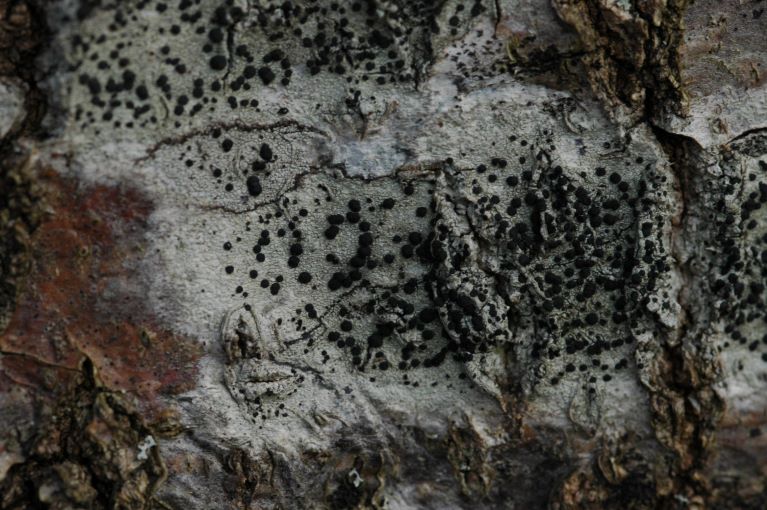Fungi Species Recorded At Woolston Eyes
A definition of a ‘Fungi’ is typically; any of a diverse group of single or multi-celled organisms that live by decomposing and absorbing the material in which they grow comprising the mushrooms, moulds, mildews, smuts, rusts and yeasts. The fruitbodies we see only represent the reproductive organ of the greater fungi organism but as these are generally the only part externally visible, it is commonly erroneously considered to be the fungi itself.
- We are indebted to the Rochdale Field Naturalists ’ Society for their survey work in 2001 and 2002 which initiated our fungi records.
The systematic list of the 55 species of Fungi recorded at Woolston Eyes follows in alphabetic order by the scientific name. At least one of the common names for each species is also listed along with a brief identification summary, habitat and an image of any specimens found on the Reserve:
F01 Orange Peel Fungus (Aleuria aurantia)
Family: Pyronemataceae Identification: They usually grow in clusters and tend to develop irregular shapes, due in part to the crowding nature of growth, and can flatten and split. They are smooth, shiny and bright orange on the inside of the cup and downy white, when fresh, on the outside, becoming increasingly smooth and orange with maturity. The cup size is 20-100mm in diameter and around 20-40mm high without any visible stem or stipe. The flesh is orange when cut and the spore print is white.
Status: A common ‘cup’ fungus in Britain, on clay soils and disturbed ground in late summer and autumn.
Les Jones No.1 bed September 2012
F02 Fly Agaric (Amanita Muscaria)
Family: Amanitaceae Identification: When first erupting from the ground litter they are completely white and covered in spikey warts. As the cap grows and expand the bright red cap skin (pellicle) shows through until the cap consists of mainly red skin with the white wart scales more or less even distributed over the whole surface. The cap starts off convex but flattens with maturity and grows to 100-200mm and stands around 100-200mm high with a grooved white stem ring. The white wart scales can weather to leave just a red cap. The gills are white but gradually turn yellowish with maturity and the spore print is white.
Status: The most iconic of British fungi and one of the least likely to be confused with any other fungus. It is toxic and has the distinctive bright red cap with white scales found in a variety of woodland habitats.
F03 Grisette (Amanita vaginata)
Family: Amanitaceae Identification: Initially egg shaped the caps expands to become flat, 50-100mm diameter, but always with a small raised central area (an umbo)and is grey coloured. The edge of the cap is striated (with comb-like radial ridges). Below the skin the flesh is white and firm and the gills are white. The stem height is 120-200mm and 10 to 15mm in diameter, tapering only slightly at the cap and is white or tinged with the grey cap colour. The stem usually becomes hollow as the fruiting body matures. There is no stem ring on this Amanita species however, at the base there is a large white sack-like volva. The spore print is white.
Status: This is an infrequent and local mushroom in Britain found in July through to October.
F04 Honey Fungus (Armilliaria mellea)
Family: Physalacriaceae Identification: The cap is between 50-150mm diameter and ranges from honey-yellow to red-brown but always with a darker area towards the centre. Initially convex the caps flatten and often develop wavy edges with maturity and when young fine scales cover the cap but do not always remain evident. The cap flesh is white and firm. The gills are flesh coloured turning yellowish and finally developing rusty spots with maturity. The stems are also white when young but fade yellowish to yellow-brown have a pale yellowish stem ring and are around 5-15mm in diameter and 50-150mm tall with a fine woolly surface. The spore print is very pale creamy white. The name Honey Fungus has nothing to do with the taste, some records make reference to the colour of the fungus itself but collecting a few and tying them in a polythene bag and left in a dry warm place will reportedly replicate the smell of honey. They are also bioluminescent but very weakly so.
Status: Widespread and common throughout Britain, most noticeable in autumn.
Brian Gort No.3 Bed 01/04/2014
F05 Jelly Ear Fungus (Auricularia auricula-judae)
Family: Auriculariaceae Identification: The outer surface of the lobed fruiting body is tan-brown with a purple tinge and covered in a fine greyish velvety down but the inner surface is smooth. Individual lobes grow between 30-100mm across. The spore print is white.
Status: Fairly widespread and frequent in Britain, the Jelly Ear fungus is seen mainly, but not exclusively, on dead Elder wood in damp, shady locations. It is best looked for in late summer through autumn although they can be found all year round.
F06 Yellow Cow-pat Toadstool or Yellow Fieldcap (Bolbitius vitellinus)
Family: Bolbitiaceae Identification: It has a yellow-dull brown cap, 10-40mm diameter, which is grooved/striated at the edges and has a clear sticky coating when young which quickly dries in the sun to a silky finish and turns grey with maturity before rotting away by the following day. The, gills yellow changing to cinnamon and a white/yellow stem which is between 2-4mm in diameter, hollow and very easily damaged with no ring. The spore print is cinnamon to rust-brown
Status: This is one of the shortest lived fungus encountered and is common and widespread in Britain. It grows from a bright yellow egg shape emergence to a brown to pale-brown toadstool in less than a day and occurs on rotting hay, grasses and cow-pats and wood mulch in full sun or shade through most of the year.
F07 Bowl Hoodie (Calyptella capula)
Family: Marasmiaceae Identification: Found on wood and thick plant stems and on first sighting resemble small flowers more than a fungus as the fruiting bodies form clusters of pure white to yellowish cups and tapered funnels. They have a smooth outer surface and are around 1-3mm long and up to 4mm in diameter hanging on the underside of branches, twigs and stout stems or drooping from the shrub or plant stem itself.
Status: Widely distributed but localised in England, tending to coastal regions in Wales and scarce in Scotland.
F08 Silver Leaf Fungus (Chondrostereum purpureum)
Family: Meruliaceae Identification: The fungus, infrequent but widespread in Britain, attacks wood and is evident on the leaves of deciduous trees and shrubs, especially fruit trees, roses, Hawthorn, Poplar, Maple and Oak, which develop a silvery sheen in summer. Following the appearance of the silvery sheen, affected branches die. Can be detected by cutting across a branch showing the silvery leaf sheen, an irregular dark stain may be seen in the centre, not necessarily corresponding to the heartwood. The leathery fruiting bodies appear from late summer through autumn. These start as just a crust on the wood but develop into intergrowing brackets around 30mm broad being lilac to deep purple patches with white edges and fine pores on the under-surface.
Status: Similar silvering symptoms may sometimes develop as a result of non-disease forms of stress. This is known as false silver leaf and can be told apart from true silver leaf by the absence of stain in the wood when cut.
F09 White Spindles (Clavaria fragilis)
Family: Clavariaceae Identification: Simple white worm like protuberances around 20-100mm tall and 4-5mm across. These fingers are more often straight with rounded tips but can be slightly flattened, wavy and/or forked near the tip. Close examination will often reveal longitudinal grooves in the surface. The tips yellow with maturity and finally turn brown with age. The spore print is white.
Status: Widespread and fairly common in Britain on unimproved grassland type habitats, from June to November.
F10 Pipe Club (Clavariadelphus fistulosus var. contorta)
Family: Typhulaceae Identification: Is basically a simple club shaped fungus, occurring singularly or in tight clusters, which become twisted and irregular protuberances of pinkish-brown, pale-brown colour and around 40mm in height. Flesh is yellowish and firm.
Status: Localised and rather rare in Britain. occurs on dead branches of living deciduous trees, especially Hazel and Birch over the winter period.
F11 Tawny Funnel Cap (Clitocybe flaccida)
Family: Tricholomataceae Identification: The cap is convex, around 40 to 90mm diameter and later usually funnel shaped with a wavy in-rolled margin; smooth and matt; tawny or orange-brown. The caps turn paler as they gradually dry out, eventually becoming buff. Tawny Funnels that appear very late in the season sometimes have convex caps that do not develop central depressions - a cause of confusion. The gills start white but become tawny with age. The stem is 30-50mm high and around 5-10mm thick, downy at the base, no stem ring and slightly paler than the cap. Spore print is creamy-white.
Status: Very widely distributed and common in Britain. Generally occurring in woodland habitats but can be found in rich humus soil conditions away from woodland. Typically an autumn fungus can be very late with fruiting bodies, sometimes in January. Is gregarious and forms large ‘fairy rings’.
F12 Butter Cap (Collybia butyracea)
Family: Marasmiacea Identification: It gets its vernacular name, not from a visual aspect, but from the greasy, buttery, feel of the cap which is 30-70mm diameter and with a distinct centre bump, ‘umbo’. It is very variable in colour but is generally a ochre-brown, which pales with age and with a cream edge around the cap. The stems are tough and flexible around 15mm diameter and the same colour as the cap and has no ‘volva’ at the base or stem ring.
Status: This is a widespread and common mushroom in Britain from autumn to early winter.
F13 Common Ink Cap (Coprinus atramentarius)
Family: Psathyrellaceae Identification: They are usually found in clusters but can be solitary. The caps are grey to pale-brown, browner at the cap centre, around 30-70mm diameter, and are conical when young but flatten and disintegrate to a black inky fluid. The stem is white-grey, 15mm diameter and around 70-170mm tall and the gills are white-grey but rapidly turn black. The spore print is dark brown.
Status: The ‘ink caps’ are named from the crude writing inks that were obtained from the decaying caps. Common Ink Caps are widely distributed and frequent in Britain from late summer through to early winter. They are found on a variety of decaying deciduous trees and buried wood.
F14 Shaggy Ink Cap (Coprinus comatus)
Family: Agaricaceae Identification: The shaggy cap is a long, white cylinder with shaggy, upturned, brownish scales. The gills are whitish, turning pink then black before liquefying from the rim inwards. The entire mushroom is very fragile and crumbles easily. The older it gets, the shaggy part start to gradually dissolve into a black, inky fluid, leaving only the standing stalk. Grows to 100-150mm tall. The stem is 10-15mm thick, white, hollow and brittle with a white stem ring which often detaches and slips down the stem. The spore print is black.
Status: This is a distinctive fungus which is unlikely to be confused with other fungus families. It is widespread and common in Britain from April to November.
F15 Trooping Crumble Cap (Coprinus disseminates)
Family: Psathyrellaceae Identification: The cap starts as a conical bell with pleats, 5-15mm in diameter and stand 10-20mm high but flattens with maturity. They vary in colour only slightly from a pale buff-brown to clay grey and are very fragile and suit their synonym ‘Fairies Bonnets’. The gills start white, turn grey-brown and eventually black, but they do not dissolve into black ink as other Coprinoid mushrooms. The stem is white, bare, thin, hollow and easily damaged. The spore print is black.
Status: Very common and widespread in Britain, found from August to November and found in clusters, often very dense, massed around old stumps or buried wood of deciduous trees.
Andy Weir No.3 Bed 05/10/2013
F16 Glistening Ink Cap (Coprinus micaceous)
Family: Psathyrellaceae Identification: This is a bell-shaped fungus which usually occurs in small groups with a cap reaching 20-40mm diameter, creamy-ochre coloured which darkens towards the centre and often has radial grooves. The cap is covered with a glistening powder. The gills are white when fresh becoming purple-brown and then black before liquefying. The stem is brittle and hollow, brownish at the base, around 5mm diameter and 40-100mm tall. The spore print is very dark-brown or black.
Status: Widespread and common in Britain, found from April to October associated with dead and buried wood.
F17 Japanese Parasol Toadstool (Coprinus plicatilis)
Family: Psathyrellaceae Identification: This species is small, dirty white to pale grey-brown with a cap 10 - 20mm diameter, domed when fresh but becoming flat on maturity. The upper surface pleated and a centre smooth spot generally brownish. The stem is thin, 1-3mm, fragile, up to 70mm tall, hollow with no stem ring. The spore print is black. Fruitbody generally only lasts for a day
Status: Fairly common in UK and widespread, found singly or in small groups, often after rain in soil amongst grass and woodland edges from late spring to autumn.
F18 Variable Oysterling (Crepidotus variabilis)
Family: Inocybaceae Identification: A tiny species, generally kidney shaped, virtually stemless, that appears on dead twigs of deciduous broad-leaved trees in the autumn and winter. The cap is initially white, turning creamy-ochre with age around 5-20mm in diameter. The gills, which radiate from the point of attachment, are white at first turning yellow-brown or buff with age. Spore print is a pinkish-buff.
Status: Common UK woodland species.
John Blundell on rotting timber structure No1 bed 07/02/2022
F19 Common Jellyspot (Dacrymyces stillatus)
Family: Dacrymycetaceae Identification: Can occur any time of the year during periods of wet weather. Orange-yellow when moist and young turning brown and translucent with age. Tiny ‘blobs’ slightly flattened 1-8mm across and 4mm tall in large groups on dead broadleaved or conifer wood, including posts and fabricated structures usually already well rotted.
Status: Common and widespread in the UK.
Douglas Buchanan No3 bed 15/11/2014
F20 Blushing Bracket (Daedaleopsis confragosa)
Family: Fomitopsidaceae Identification: Very common in the UK, especially along streams, rivers and any damp woodland places. Usually kidney shaped, slow growing up to 200mm across and 40mm deep. The crown is coloured brown to reddish-brown from warty growths except the outer edge which gives rise to a concentric ringed outer surface free of warts. The underside pores are white at first but with age mature to browns and finally grey colours and bruise a light pinkish-brown colour. The spore print is white.
Status: Found on trees and decaying branches. Often in groups or tiers up the trunk or bough. Willow at Woolston is a common host.
F21 Moss Bell (Galerina hypnorum)
Family: Strophariaceae Identification: A tiny fungus, pale brown, ochre-brown with a cap opening to an acute cone shape with fluted/striped appearance and deep gills underneath. Total height 30-60mm and cap diameter circa 5-15mm. The stem tapers slightly from a small swollen base to the cap.
Status: Found in damp mossy conditions.
John Blundell No.1 bed 25/10/2021
F22 Scarlet Waxcap (Hygrocybe coccinae)
Family: Hygrophoraceae Identification: Are small bright red and wet looking toadstools. It is often confused with the Crimson Waxcap which is larger, has a much darker cap and is much less common. The cap is 20 to 50mm in diameter, convex at first becomes bell shaped and then flattens with maturity. Initially blood-red the colour fades to orange then yellow tones from the edge. The cap flesh is orange. Gills are reddish-orange fading with maturity to more orange-yellow. The stem is red near the cap but fades to orange and often yellow tones near the base, it has no stem ring. Stem diameter is 5 to 8mm and 30 to 60mm tall. Spore print is white and fruiting September to November.
Status: Fairly common, they grow in clumps in wet short grass and woodland clearings.
John Blundell No.1 bed 27/10/2021
F23 Sulphur Tuft (Hypholoma fasciculare)
Family: Strophariaceae Identification: The name gives an indication of the nature of this species which is yellow and grows in tight clumped tufts. The cap is a bright yellow grading to a tan towards the centre and paler on the edges, convex and around 70mm in diameter. The cap flesh is sulphur-yellow and firm. The gills are at first bright yellow but becoming greener and progressively darkening on maturity. The stem has a similar colouration as the cap, yellow at the apex and grading browner to the base and is around 5 to 10mm in diameter and 50 to 120mm tall. The spore print is purplish-brown.
Status: Common on decaying timber, trees, stumps and fallen limbs on a wide variety of species.
F24 Amethyst Deceiver (Laccaria amethystea)
Family: Hydnangiaceae Identification: This is a coloured fungus, violet-purple when wet and pale grey, with a hint of violet tones, when dry. The caps, 20-70mm diameter, are initially convex but become almost flat topped with age. Old caps become almost white in dry weather, paling from the centre out but eventually the whole fungus ages to a buffy colour. The gills are broad and deep and are the first to fade in colour as the spores and spore print are white. The stems are 5-10mm in diameter and 50-100mm high, often bent and twisted and are deep purple when young and increasingly hairy towards the base.
Status: Widespread and common in the UK on dark damp leaf litter and mosses in woodland, especially beech, usually in small groups.
F25 Deceiver (Laccaria laccata)
Family: Hydnangiaceae Identification: This common fungus is very variable and not easy to specifically identify with certainty as the caps are found in so many shades often together in the same grouping. Cap 20-70mm diameter, initially convex but become flat when aged. During wet weather young caps turn deep tan or reddish-brown but often orangey. In dry spells caps turn paler buff and eventually almost white. The gills are broad, widely spaced and deep and are the first part of the fruitbody to pale as the white spores coat them. Spore print is hence white also. Stem is 5-10mm diameter and 50-100mm long and increasingly hairy towards the base, fibrous and hollowing.
Status: Widespread and common throughout the UK in all species of woodland in June through to November.
F26 Oak Milkcap (Lactarius quietus)
Family: Russulaceae Identification: A nondescript fungus. Caps 40-90mm diameter starting convex but flattening and slightly depressed with aging. Yellow-brown to reddish-brown, shiny when wet and mat when dry. The gills are crowded, creamy-brown to a pinkish-yellow, turning browner with age and exude a creamy-white milk when damaged. Stem 5-10mm in diameter and 50-70mm in height is the same colour as the cap but darker towards the base and no stem ring. Spore print is creamy white with a salmon tinge.
Status: Common and widespread in UK, mycorrhizal with oak trees only and found from August to October.
F27 Ugly Milkcap (Lactarius turpis)
Family: Russulaceae Identification: A dull olive-brown fungus, slimy and shiny when wet but dull and matt when dry. Cap from 70-180mm diameter, olive-brown with paler margin, initially convex but flattens with age usually with a slight depression in the centre. Gills cream to pale buff crowded which tinge sepia when bruised and exude a creamy-white milk when damaged which dries to olive-brown. Stem coloured as cap, 10-25mm diameter tapering to base, no stem ring, 40-70mm long. Spore print creamy-white. When exposed to drops of potassium hydroxide the cap immediately turns purple.
Status: Fairly common and widespread in UK, found under birch in acid soils, especially in wet woodland edges.
David Riley No.1 bed 24/07/2020 & 06/10/2021
F28 Orange Birch Bolete (Leccinum versipelle)
Family: Boletaceae Identification: The cap, orange, ranges from 80-200mm diameter and remains largely convex throughout. Has pale thick stems tapering at the apex, 20-40mm diameter, with dark grey scales, squamules. When cut or handled the stem quickly turns grey at the apex but blue-black towards the base and is an identification aid. The spore print is brown, yellow-brown. Very similar, but far less common, to the related Brown Birch Bolete which also occurs under Birch trees but has a brown cap and when cut the flesh does not display the marked colour change.
Status: A not uncommon large mushroom occurring under Birch trees in Britain, found from July to September.
F29 Parasol Mushroom (Lepiota procera)
Family: Agaricaceae Identification: Common in southern UK, less frequent in northern areas. Cap initially globular and pale brown with a dark brown crown which breaks upon growing to create the scales. This species expand the cap until it is flat up to 250mm diameter for a large specimen with a small raised bump in the centre called an ‘umbo’. The flesh is white and does not change significantly when cut. gills are white to cream and only spread inwards some distance from the stem. A stem skirt persists but can fall to the base in maturity. The stem is smooth and white or cream but decorated with dark brown scales which persist. The stem flesh is white and sometimes hollow. The stem is circa 10-15mm diameter in the parallel portion, swollen at the base and tends to taper at the apex. Height can reach 300mm. Spore print is cream or white.
Status: Found in various woodland, Willow is a preferred host and less often Birch.
Andy Weir No3 bed 5th October 2013
F30 Shaggy Parasol (Lepiota rhacodes)
Family: Agaricaceae dentification: Cap is initially dome shaped when young then expands to circa 150mm diameter but rarely to completely flat. The cap layers separate as the specimen grows creating the ‘shaggy’ appearance of the cap surface. The gills are white and soft. The stem skirt, shown in the photograph can fall to the stem base on maturing fruitbodies. Fruiting body June to October Spore print white or pale-cream. When cut or bruised the cap, gills and stem flesh turns reddish.
Status: Associated with a variety of woodland.
F31 Wood Blewit (Lepista nuda)
Family: Tricholomataceae Identification: Often forming ‘fairy rings’ the cap is large at 60-150mm diameter, grey-brown in colour with a distinct violet tinge and a slight inrolled margin until the violet tinge fades and the surface turns buff with a mid-brown centre. The gills are crowded and have a lilac tinge which turns buff then brown through aging. Stem is thick, 15-25mm diameter tapering out slightly at the base.. The whole fungus is stout and solid looking which together with the violet tinge separates it from all the other purple-blue-lilac species. The spore print is pale pinkish-buff.
Status: Common and widespread in UK, found in leaf litter in mixed deciduous woodland and sometimes hedgerows. Most common from August to December but can be seen at any time of the year.
F32 Slime mould or Wolf's Milk (Lycogala epidendrum)
Family: Tubiferaceae Identification: The fruit bodies appear either scattered or grouped as small cushion like blobs around 3-15mm in rough diameter. The colour is quite variable from pinkish, grey, yellowish brown and greenish-black with the mature individuals tending to the darker colours. They maybe round, or somewhat compressed with a warty or rough texture. When immature they are filled with a pink paste like fluid but on maturity are filled with a mass of minute grey spores. Slime moulds are a species of myoxgastrid amoeba, individual cells of a reddish amoeba like organism not a fungus. These amoeba, plasmodia, amalgamate to form the aethalium, the visible fruit bodies,
Status: Common and widespread in UK, found on damp rotting timber, especially large logs June to November.
F33 Common Puffball (Lycoperdon perlatum)
Family: Agaricaceae Identification: Typically this fungus is an inverted pear shape 30-60mm diameter and 40-90mm in height. Its surface is covered in pearl like stipules which distinguish it from its many similar relatives. In maturity these pearl stipules fall away to reveal an intricate ochre and white net pattern over the inner spore sac. There is a darker area at the apex which develops a pore hole through which a spores are released by pressure on the outer skin from rainfall or animal disturbance. The stem of the puffball is effectively an inverted cone and may contain an amount of spongey, infantile material. The spores are olive-brown becoming darker when fully mature.
Status: Widespread and common found in woodland of all kinds, also in scrub and grassland and is usually in groups or small lines or fruitbodies from July to November.
F34 Stump Puffball (Lycoperdon pyriforme)
Family: Agaricaceae Identification: A gregarious species often in very densely packed groups. The ball is 15-40mm in diameter and the fungi 30-40mm high and pestle to pear shaped fruitbody is initially white and covered in short warts. With maturity, the skin turns brown and the apex turns darker as the spore hole develops. The stem is short and spongy, parallel or tapering at the base and contains infertile material which stays white even when the fruitbody is fully matured. The spores are olive-brown turning darker on full maturity. Sometime the fungus looks like it is growing in soil but investigation will reveal a buried trunk or large bough as an aid to identification.
Status: Widespread and very common in the UK. Found growing on decaying tree stumps and well-rotted fallen branches. The only puffball in the UK which grows on wood and not directly in soil.
F35 Clustered Domecap (Lyophyllum decastes)
Family: Lyophyllaceae Identification: This species varies greatly in size and colour, from yellow-browns, browns through to bluish tinged greys, and is a clump forming fungi. The cap is between 40-100mm in diameter, convex but sometime only shallowly domed and usually irregular in shape, distorted and margins scalloped. The cap is shiny and peels easily. The gills are crowded, pale greyish which turn yellow-brown with age. The stem is roughly 10-20mm diameter and 40-80mm high and usually curved as multiple stems meet at the base, grey-white to grey-brown with no stem ring. The spore print is white.
Status: Common and widespread UK fungus of deciduous woodland margins, clearings, commons, parks and especially any disturbed soils.
F36 Orange Mosscap (Mycena fibula)
Family: Mycenaceae Identification: A reddish-orange to pale yellow fungus which becomes paler with age, singular or spaced groups. Young specimens are semispherical with rolled in margins which open during maturity often splitting the caps and distorting them which are around 10-20mm in diameter. The gills are pale, widely spaced, deep and extend down the stem giving a vertical fluting appearance from below. The stem can be less than 1mm in diameter, parallel but tapering at base, circa 20-40mm high, yellowish at the cap but very pale at the base and the flesh white with a thread-like hollow. Spore print is white.
Status: Relatively common in the UK, found in damp leaf litter and especially mossy places.
F37 Dark Milking Bonnet (Mycena Leucogala)
Family: Mycenaceae Identification: The caps are roughly 10-20mm diameter, conical, translucent with a stripy appearance from the gill shadow beneath and black-brown to bluish-black in colour and a distinct browning at the margin. The gills are widely spaced, deep whitish when young turning more greyish or brownish with a whitish edge on aging. The stem to 65mm and around 2mm in diameter, parallel, hollow and the same colours as the cap, dark brown towards the cap turning blacker towards the base and exuding a milky sap when broken. Spore print white.
Status: Found on debris and decaying litter in deciduous, conifer woods, hedgerows and in moss July to November. Considered a variant of Mycena galopus or separate species by different bodies.
F38 Coral Spot (Nectaria cinnabarina)
Family: Nectariaceae Identification: Having a complex life cycle the first evidence on dying twigs and usually small branches are many pin-head sized pink fungal blobs break through the thin bark over a large area of the timber. These blobs harden and turn dark-reddish brown, 1-4mm across, by which time the timber is so decayed it falls from the tree in windy weather. Spore print is white.
Status: Common and widespread in the UK, found on broadleaf trees, Beech in particular but also Sycamore, Horse Chestnut and Hornbeam but not conifers. Summer and autumn fruitbody but can be found at any time of the year.
F39 Beech Jellydisc (Neobulgaria pura)
Family: Helotiaceae Identification: A pinkish-brown gelatinous flat disc shaped fruitbody from 0.5-15mm diameter and up to 8mm high with no visible stem. Clump forming which results in distortion of the disc shape as bodies push and grow into each other. Spore print is white.
Status: Uncommon in the UK but not a rare woodland species found on dying branches of living trees but generally on decaying fallen trunks and branches of broad-leaf trees, especially Beech during the summer and autumn.
F40 Brown Mottlegill (Panaeolina foenisecii - there is no concensus on the taxonomic family for this species)
Family: Bolbitiaceae Identification: Caps are 10-20mm diameter are initially conical expanding to broadly convex and mid to dark brown when wet but dry from centre out to a creamy beige. The gills are quite open, initially pale brown becoming mottled dark brown on aging. Stem is 3-5mm diameter, no stem ring, and 40-70mm high, light brown and turning creamy toward the base. Spore print is dark brown.
Status: Common and widespread in the UK this fungus is the most common of the common ‘lawn mushrooms’ on any frequently mown area not regularly fertilised through April to December.
F41 Brown Rollrim (Paxillus involutus)
Family: Paxillaceae Identification: Caps are convex when young with in-rolled margins, an ochre brown, which flattens and soon becomes centrally depressed with a raised centre pip, umbo, and changes to a darker chestnut brown. The margins remain in-rolled throughout. 50-120mm diameter when mature the caps are sticky when wet but dry slightly downy and become smooth when old. The gills are crowded, a pale ochre when young aging to brown with rusty spots. If bruised they turn rusty brown very quickly. Stem is 8-15mm diameter and usually from 60-120mm long but usually curved and is parallel, light-brown at first but aging to a chestnut colour or if bruised. Spore print is yellow-brown.
Status: A common and widespread fungus in UK found in broad leaved woodland habitats and associated especially with Birch but with other trees on acid soils from July to October.
F42 Cinnamon Porecrust (Phellinus ferreus)
Family: Hymenochaetaceae Identification: This species does not have a ‘traditional’ mushroom or toadstool shaped fruitbody but initially forms numerous small yellow-brown cushions which grow and fuse to form a carpet of crust like fruitbody which is rusty brown. Without gills, the spores are released through small pores on the crust, tubes 2-5mm deep, which are brown and number 4-6 per mm. The spore print is white.
Status: Fairly common and widespread brown crust fungus in the UK on a variety of dead broadleaf wood species but Hazel in particular.
David Bowman No.3 bed 04/10/2017
F43 Shaggy Scalycap (Pholiota squarrose)
Family: Strophariaceae Identification: Cap is 40-120mm dia. coloured straw to yellow-ochre, has upturned brown scales in apparent concentric rings. Convex then flattening but retain the in-rolled margin. Cut flesh is pale yellow & firm. Gills greyish-yellow, crowded, joined to the stem, with a veil covering when young, turning to cinnamon on maturity. The stem is 7-15mm dia. 60-150mm long, has a change point from scales to smooth & pale. Usually in small clusters where found. The spore print is a rusty brown.
Status: Locally common but infrequently come across in the UK. Found at the bases of old and felled stumps of broadleaved trees and conifers notably Beech and Spruce especially when growing in open grassland or clearings on alkaline soils in August to November.
F44 Oyster Mushroom (Pleurotus ostreatus)
Family: Pleurotaceae Identification: A highly variable species in both colour and shape. In general, they are whitish, cream or brown but blue-grey is also known and they are usually bracket like, kidney, shaped with a radial or eccentric stem fixing the specimen like an ear onto the timber. 50-180mm across in size they often grow in overlapping groups but with each stem separately attached. Gills are crowded, white turning ochre with maturity and the attachment stem if apparent is small 10-30mm long and 10-20mm in diameter tapering towards the base, white to cream, woolly at the base and no stem ring. The spore print is white to pale lilac-grey.
Status: Widespread throughout UK and fairly common. Almost exclusively found on deciduous trees dead or standing and fallen trunks and large branches, in particular Beech and Oak. Found high up a tree or on the ground.
F45 Lumpy Bracket (Pseudotrametes gibbosa)
Family: Polyporaceae Identification: A standard semi-circular bracket shape 50-200mm across and 10-60mm thick but can form rosettes on stump tops. White, often with pinkish rounded edge when clean, downy when young but with age the surface becomes leathery, covered in algae and dirt loses the down and the edge becomes more acute. The spore tubes terminate at the surface underneath in irregular elongated pores, cream at first but age to ochre. These slot-ike pores are diagnostic to this species, all other polypore have round or oval pores. The spore print is white.
Status: Fairly common and widespread in UK, found on broadleaf trees, standing, stumps or fallen trunks and large branches, especially Beech and Sycamore in late summer and autumn.
John Blundell specimen on Sycamore leaf, a plant species on which it is commonly encountered, No1 bed 27/08/2021
F46 Tar Spot (Rhytisma acerinum)
Family: Rhytismataceae Identification: It appears initially as yellow blotches on the leaves in spring. These develop into slightly raised , shiny, black spots dotted over the leaf surface. The outer edge is usually bordered brown and is around 10-15mm across.
Status: A very widespread, common and conspicuous fungus on Sycamore and other Maple leaves which does very little damage to the living tree but can cause premature leaf drop.
F47 Purple Brittlegill (Russula atropurpurea)
Family: Russulaceae Identification: A large mushroom with a cap around 40-100mm in diameter, convex at first then flattening and developing slightly depressed centes in maturity. They are reddish-purple around the cap rim (note: older specimens can be bleached of colour on the rim) deepening in colour to purple and very dark towards the center. The gills and thick even stem are white to creamy in colour. The spore print is ochre.
Status: Common fungus around woodlands throughout Britain especially under Oak and Pine trees.
David Hackett No.1 bed 05/02/2015
F48 Scarlet Elfcup (Sarcoscypha austriaca)
Family: Sarcoscyphaceae Identification: It forms a generally round but irregular shaped cup from 20-70mm diameter and 10-20mm high with the edges often curling inwards. The inside of the cup is bright red and smooth, the outside is paler and covered in fine hairs. Observed under strong magnification these are in the form of tangled coils which is diagnostic for this species. The related Ruby Elfcup has tangled straight hairs.
Status: Fairly frequent and widespread throughout Britain, found on fallen branches and twigs especially partly buried in moss, most abundant in late autumn and winter.
F49 Common Earth Ball (Scleroderma citrinum)
Family: Sclerodermataceae Identification: The roundish ball of the body has no stem and is initially whitish, cream or yellow and may turn brown or greenish on aging. It is covered with coarse scales of irregular shape and size. The body skin ruptures on maturity leaving an irregular opening from which the spores emerge via wind and rain assistance. Empty earthball skins can persist for months in sheltered locations. The inside of the ball is white at first, turning brown with white marbling before turning purple-brown throughout.
Status: A common fungus of woody and short grassland areas around 40 to 100mm in diameter found from July to December.
F50 Eyelash Cup (Scutellina scutellate)
Family: Pyronemataceae Identification: The visible fruiting bodies form small red cups, 3-10mm diameter, which open and flatten in maturity. They have distinctive long dark hairs, ‘eyelashes’ on the outer edge which are visible but clearly so under a magnifying glass. The cup center is orange-red and browner on the outside which is covered in stiff dark hairs up to 10mm in length which resemble eyelashes on the cup rim. The flesh is red and thin.
Status: Found on rotting wood and other humus rich damp habitats and is widespread and common in Britain from late spring to late autumn.
F51 Verdigris Agaric (Stropharia ruginosa)
Family: Strophariaceae Identification: The bell shaped caps are uniform coloured much nearer to green than blue and are very slimy when new and noticeably glossy, standing out amongst the general floor litter. With age they gradually flatten, size between 25-80mm diameter, and the colour pales to brownish-tan from the centre outwards. Small white veil fragments can be seen on the cap and its rim, more noticeable in younger specimens. The stem is pretty much uniform in diameter up to the cap and has a brownish ring below which the stem is covered in fine white flakes/scales. Spore print is purple-black.
Status: This is one of only a few green-blue fungi and is very localised in Britain, mainly on alkaline humus.
F52 Earth Fan (Telephora terrestris)
Family: Thelephoraceae Identification: It resembles a rosette-like fan with the upper face reddish-brown to dark-brown, often paler at the margins and with darker banding in the rosette. There is no stem to speak of, a rudimentary one at best, and grows to 60 -150mm diameter. The underside of the rosette is lighter brown to mid-brown. The spore print is purple-brown.
Status: Usually associated with pine woods it does however occur with deciduous trees as Oak, Birch and Willow. It is widespread and common in Britain.
F53 Yellow Brain (Tremella mesenterica)
Family: Tremellaceae Identification: t is a bright yellow jelly fungus and mature specimens resemble the convoluted folds of a human brain sprouting from decaying wood. It is best looked for in wet weather as in dry spells it shrivels to a hard rubbery patch on the wood which is more difficult to pick out.
Status: Principally found in the autumn-winter period on fallen deciduous trees and branches which has already been attacked from other wood rotting fungi and is widespread and common throughout Britain.
F54 Stubble Rosegill (Volvariella speciose)
Family: Pluteaceae Identification: Has a white to greyish cap, paler at the cap edge graduating greyer and brownish to the centre. Initial bodies are ovoid, like an egg, but the cap becomes convex and even flattens around 5-10cm across. The cap is smooth but slimy when young, sticky when moist and silky when dry. The stem white, around 10-15mm diameter tapers towards the cap and is without a stem ring but retains a volva, baggy sac, at its base. Usually reaches around 50-90mm in height. When cut the flesh is white throughout. The spore print is pink.
Status: Fairly common throughout Britain. Occurs as single specimens or in groups associated with rich humus such as woody, grass and other organic mulch.
David Bowman No.3 bed 06/02/2017
F55 Candle Snuff (Xylaria hypoxylon)
Family: Xylariaceae Identification: A black fungus throwing up fingers to 50mm then develop white powdery tips in autumn and over winter. The fingers branch to resemble ‘antlers’ or ‘candlestick’ forms as the fungus develops. On maturity, in spring, the white coating disappears leaving the antlers all black. It is bioluminescent, although very weak.
Status: This is an unmistakable fungus occurring in groups and is best looked for in the winter months. It is a fungus of dead and decaying wood, mainly deciduous but sometimes also pine.
F56 Undetermined Amanita species
Family: Amanitaceae - Species: Amanita sp.
Identification: A species of Amanita, Agarics, was found which was not ‘muscaria’ (Fly Agaric) or ‘vaginata’ (Grisette). Amanita is a large genus and the order usually have white spores, a stem ring slightly below the cap, a veil which breaks up as the cap expands and a domed cap which flattens with age and contain some of the most toxic mushrooms.
F57 Undetermined Cone-Head species
Family: Bolbitiaceae - Species: Conocybe sp.
Identification: Conocybe is a genus of mushrooms with most quite delicate with a long thin stem and a conical shaped cap and are collectively known as ‘cone-heads’ because of this. Separation of some of these species with similar ‘Galerina’ species is difficult in the field and hence this record just refers to a Conocybe sp.
Status: Conocybe sp. are common and widespread in the UK usually on more fertile habitats as grassland, moss, dung and decaying wood.
F58 Undetermined Hebeloma species
Family: Hymenogastraceae - Species: Hebeloma sp.
Identification: Hebeloma is a large genus of typical mushroom form, cap, gills, and stem, but identification of species can be tedious and require microscopic examination. The specimen found was left as Hebeloma sp.
F59 Undetermined Marasmius species
Family: Marasmiaceae - Species: Marasmius sp.
Identification: A large genus of typically small brown unimpressive mushrooms found in leaf litter that can require microscopic examination is necessary to identify and separate from some collybiod and mycenoid species.
F60 Undetermined Melanoleuca species
Family: Tricholomataceae - Species: Melanoleuca sp.
Identification: Most of this genus are small to medium sized brownish to whitish mushrooms with few distinctive features and can require microscopic examination. The specimen found was not closely examined and left as Melanoleuca sp.
F61 Undetermined Melanoleuca species
Family: Marasmiaceae - Species: Marasmius sp.
Identification: A large genus of typically small brown unimpressive mushrooms found in leaf litter that can require microscopic examination is necessary to identify and separate from some collybiod and mycenoid species.
F62 Undetermined Russula sp. (Red and Yellow Capped)
Family: Russulaceae - Species: Russula sp.
Identification: This family is notorious for pin-pointing the precise species from the 20-30 often referenced in field guides. Suffice it to say Russula are reddish but sometimes orangish or yellowish and no attempt to separate will be made in this summary.
The general species description is they have a convex to flat cap, around 8-10cm diameter, with white or creamy gills underneath and a smooth white stem around 10cm high and fairly even thickness of 2cm. The cap colour will be left as stated above. It is widely distributed and grows on damp humus, common around pine trees.
F63 Undetermined Stereum species – not Rugosum
Family: Stereaceae - Species: Stereum sp.
Identification: One of the fourteen Stereum species occurring in Britain which was not identified to a specific species. They are simple small bracket shaped membranes appearing on dead wood. The underside contain spore but no gills as ‘cap and stem’ mushrooms. They can be split into two groups those which exude a reddish liquid (blood) at cut surfaces and those which do not.
F64 Undetermined Tricoloma species
Family: Tricolomataceae - Species: Trocoloma sp.
Identification:One of the 50 known species of Tricoloma found in Britain which was not separated to a particular species.
The general characteristics of the family are; fleshy, white gilled mushrooms. The cap is often connected to the stem by means of a small notch. Colour varies from yellowish to greys and through to browns and though many of the genus species can be identified on physical characteristics these are often variable and hard to discern with exactitude and microscopic examination is an additional aid.
L0 What is a Lichen?
Lichens are made up of two or more closely interacting organisms, a fungus, and one or more partners, called photobionts. The photobiont may be an alga and/or cyanobacteria, both of which can produce simple sugars by photosynthesis. In contrast, fungi are ‘heterotrophic’ and require an external source of food. The photobionts provide the food and the fungi build the structure of the lichen thallus, within which they provide conditions for a long term, stable association with their photobionts, the basis of the lichen symbiosis.
- The are no current identified species of Lichen on the Reserve, they are present but we do not have the expertise to identify specimens down to a species, We have however, included examples found on the Reserve from three of the basic growth forms commonly found Crustose, Foliose and Fruticose.
John Blundell located on birch twigs No.1 bed 21/01/2022
L01 Bushy Fruticose Lichen poss. Evernia prunastri
Family: Parmeliaceae - Species: Evernia sp.
A common tree lichen. Example thought to be Evernia prunastri, a blue-green lichen with flattened forked branches which are whitish underneath.
John Blundell growing on birch twigs No1 bed 21/01/2022
L02 A foliose lichen
Family: poss Parmeliaceae - Species: poss Parmelia sulcata
Foliose, a flattened leaf-like, lichen. A tree lichen, the blue-green upper colour and dark underside shading to lighter brown at the edges suggested Parmelia sulcata.
John Blundell No.1 bed 11/02/2022
L03 Dog Lichen (Pretigera sp.)
Identification: A foliose lichen which are generally ground dwelling and grow as flat leaf-like structures (thallis) with broad lobed edges. The colour of the top surface is variable from browns, greens to greys. The underside of this specimen is white with fang-like growths which suggest either Pretigera canina of membranacea. A better photo of the form of the fangs will identify to which of these species.
- Status: Both are common in the UK, but membranacea is the more widespread and hence probability.
John Blundell No.1 bed 11/02/2022
L04 presumed (Calondia sp.)
A fruticose lichen is a form of lichen fungi that is characterized by a coral-like shrubby or bushy growth structure. They differ from other forms of lichen because their bushy form is attached to the substrate only at the base of the lichen.

